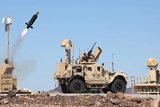Italy set to be first recipient of Leonardo’s MAIR system
Multiple Aperture InfraRed is a missile warning system based on multiple InfraRed sensors, able to cover the full angular volume around the aircraft. (Photo: Leonardo)
Leonardo’s new Multi Aperture Infrared (MAIR) threat warning system has gone into series production.
Manufacturing has begun on an initial batch of units for installation on helicopters including the Italian Army’s Light Utility Helicopter (LUH) based on Leonardo’s AW169M.
As a distributed aperture warning system, MAIR fuses data between four and six IR cameras to detect and track incoming missiles and hostile gunfire threats using their heat signatures.
Customers can also choose to purchase an additional image processor module that can deliver day and night imaging and full mission data recording capability to boost situational awareness and support navigation and landing.
IR threat warning systems offer many advantages over legacy UV systems, improving response time and tracking accuracy.
MAIR can be installed as a stand-alone threat warning system or can be integrated with countermeasures, such as a Directed IR CounterMeasure, as part of a wider aircraft protection system.
Leonardo revealed its MAIR system at the 2019 Paris Air Show and production was expected to begin in 2020, the COVID-19 pandemic may have caused delays to this schedule.
According to Shephard Defence Insight, the AW169M is designed to perform a range of light utility and armed attack roles, as well as observation and training missions.
Related Equipment in Defence Insight
More from Air Warfare
-
![How do we detect and defeat enemy drones?]()
How do we detect and defeat enemy drones?
Learn about the portfolio of sensors and effectors for the complete counter-UAS mission at Raytheon, an RTX business.
-
![BAE Systems lauds counter-UAS drone progression with live fire trials]()
BAE Systems lauds counter-UAS drone progression with live fire trials
The US-based tests successfully demonstrated the first live trial of a precision guided missile from a modified TRV-150 drone which destroyed both aerial and ground targets.
-
![India readies private sector push as AMCA moves towards 2028 prototype]()
India readies private sector push as AMCA moves towards 2028 prototype
India’s stealth fighter ambitions gain fresh momentum as HAL opens the door to private sector involvement in AMCA Mk1A structural assembly, with strategic support growing for next-gen propulsion and sensor technologies.
-
![BAE Systems reveals new GCAP demonstrator design with plans to fly by 2027]()
BAE Systems reveals new GCAP demonstrator design with plans to fly by 2027
A key part in the trinational Global Combat Air Programme (GCAP), this is the first crewed supersonic aircraft demonstrator to be built and developed in the UK in more than 40 years.
-
![Kratos Defense makes European CCA push with Airbus partnership]()
Kratos Defense makes European CCA push with Airbus partnership
Kratos’ XQ-58A Valkyrie will be equipped with an Airbus-made mission system to be offered as a ‘European’ collaborative combat aircraft option to the German Air Force.
-
![Anduril’s Barracuda-100M completes latest successful test flights]()
Anduril’s Barracuda-100M completes latest successful test flights
The munitions variant of the Barrauda-100 autonomous air vehicle is being tested for the US Army’s High-Speed Manoeuvrable Missile (HSMM) testbed programme, with further flight tests expected in 2026.























